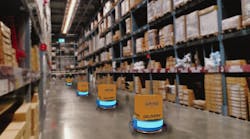Automation Will Drive Need for 1 Million Additional Warehouse Workers Through 2024
A study done by Interact Analysis of warehouses both in the U.S. and in Europe, found that that automation is driving sustained jobs growth, as automation creates a virtuous circle: robots aren’t being used to displace manual workers rather, robots are used alongside personnel to augment overall productivity. Warehouse operators and logistics companies face a critical struggle to meet the ever-increasing consumer demands that far outweigh anything that could be met with human manpower alone.
“The International Federation of Robotics has often pointed out that Germany and Japan have some of the highest concentrations of industrial robots per head of manufacturing workers in the developed world. And yet it will come as no surprise to most to learn that Germany and Japan also have amongst the largest numbers of manufacturing jobs in the developed world. The same logic applies here," said Ash Sharma, senior research director, Interact Analysis, in a statement.
He continues, “Our research shows that warehouse automation is an understandable necessity in a fast-growing market. As automation gets more advanced, it makes fulfillment cheaper and more efficient, resulting in more consumers choosing to shop online leading to greater warehousing demand. On this basis, and assuming the overall warehouse market keeps growing, the warehouse companies that automate the most will also grow the most, and therefore it will be these companies that create the most jobs of all types – including manual warehouse roles."
The evidence suggests that many of the people who gravitated to e-commerce temporarily during COVID-19 will stick with it permanently. During the lengthy periods of lockdown, huge numbers of consumers bought essentials – from light bulbs to shoes to prescriptions – that they wouldn’t previously have purchased online. For many, they will not be going back, and they want their orders sooner. The average package delivery time in the US decreased from 2.1 days before the pandemic to 1.7 days by the end of 2020, according to ParcelLab.
The research, which involved speaking to almost every single significant warehouse automation provider globally, revealed:
- The U.S. had 1.6 million warehouse employees in 2019 which is forecast to grow to just under 2 million in 2024, while Europe had 2.5 million warehouse employees in 2019 which is forecast to grow to 3.1 million in 2024.
- Both Europe and the U.S. are forecast to grow with a similar CAGR of approximately 4% between 2019 and 2024, With demand forecast at this rate, the research found that one million additional warehouse employees will be required, or 25% growth in five years.
The survey also examined which tasks required the most workers, and which were the fastest growing areas for automation. Goods-to-person (G2P) picking is the fastest growing warehouse activity – where items are delivered to sorting and packing stations. G2P picking leverages AMR’s and is scalable, enabling warehouse operators to economically automate in existing environments. Packing and conveyor induction were also in the top three fastest growing positions. These three sectors represented 17% of all warehouse roles in 2019 (over 693,000 jobs), but this figure will be 21% by 2024 (over 1,000,000 jobs) – a CAGR of 9.3%.
